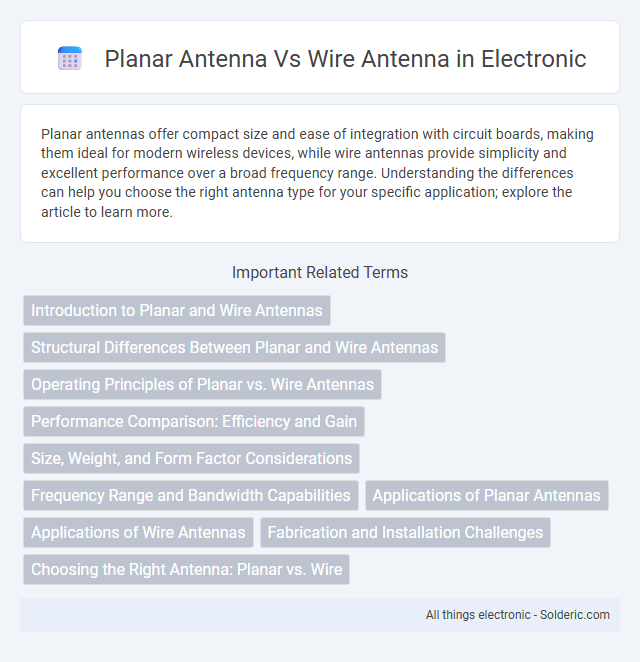Planar antennas offer compact size and ease of integration with circuit boards, making them ideal for modern wireless devices, while wire antennas provide simplicity and excellent performance over a broad frequency range. Understanding the differences can help you choose the right antenna type for your specific application; explore the article to learn more.
Comparison Table
| Feature | Planar Antenna | Wire Antenna |
|---|---|---|
| Structure | Flat, printed on a substrate | Thin, flexible conductive wire |
| Size | Compact, low profile | Usually longer and bulkier |
| Bandwidth | Moderate to wide bandwidth | Narrow to moderate bandwidth |
| Radiation Pattern | Directional or omnidirectional | Generally omnidirectional |
| Frequency Range | Microwave to millimeter-wave | HF to UHF bands |
| Manufacturing | Mass-producible via PCB technology | Simple manual or automated winding |
| Applications | Mobile devices, radar, wireless comms | AM/FM radios, base stations, HF comms |
| Cost | Generally higher due to substrate and fabrication | Lower cost, simpler materials |
| Durability | Rigid, less prone to deformation | Flexible but can be easily damaged |
Introduction to Planar and Wire Antennas
Planar antennas, typically fabricated on flat surfaces using printed circuit technology, offer low-profile, lightweight designs suited for modern wireless applications. Wire antennas, constructed from metal wires or rods, are simple, cost-effective solutions widely used in traditional radio frequency communication systems. Both antenna types serve distinct purposes, with planar antennas excelling in compact, integrated devices and wire antennas favored for broader bandwidth and ease of installation.
Structural Differences Between Planar and Wire Antennas
Planar antennas consist of flat, two-dimensional surfaces such as patches or microstrip lines, offering compactness and ease of integration on circuit boards. Wire antennas feature one-dimensional, thin conductive elements like dipoles or monopoles, which are typically longer and more flexible in shape. Your choice depends on whether you prioritize a low-profile, printed design or a traditional, stand-alone wire structure.
Operating Principles of Planar vs. Wire Antennas
Planar antennas operate by radiating electromagnetic waves from flat, conductive surfaces that create a controlled current distribution, enabling precise beamforming and polarization control. Wire antennas rely on linear conductors where current distribution along the wire generates radiation, typically resulting in simpler patterns with broader bandwidth. The surface geometry of planar antennas allows integration with printed circuit boards, enhancing compactness and frequency agility compared to the traditionally simpler wire antenna structures.
Performance Comparison: Efficiency and Gain
Planar antennas typically offer higher efficiency and gain compared to wire antennas due to their low-loss dielectric substrates and precise fabrication methods that minimize energy dissipation. Wire antennas often exhibit lower gain and efficiency as their performance is limited by the physical dimensions and conductivity of the wire materials, leading to greater resistive losses. The planar antenna's ability to integrate with circuit boards enhances impedance matching and radiation patterns, further improving overall system performance.
Size, Weight, and Form Factor Considerations
Planar antennas offer a compact, lightweight design with a low profile, making them ideal for integration into modern devices where space is limited. Wire antennas, while generally larger and heavier, provide flexibility in length and shape, which can simplify tuning and improve performance in some applications. Choosing between planar and wire antennas depends on your device's size constraints and weight requirements, with planar antennas excelling in slim, portable designs.
Frequency Range and Bandwidth Capabilities
Planar antennas typically offer wide frequency range capabilities and broad bandwidth performance due to their compact, printed circuit design optimized for modern communication systems. Wire antennas generally provide narrower bandwidth and more limited frequency range but excel in simplicity and ease of deployment for lower-frequency applications. The frequency response of planar antennas makes them suitable for ultra-wideband and multiband uses, whereas wire antennas are favored for single or narrowband operations.
Applications of Planar Antennas
Planar antennas are extensively used in modern wireless communication systems such as mobile phones, Wi-Fi routers, and satellite communications due to their compact size and ease of integration with printed circuit boards. Their low-profile design and ability to support multiple frequency bands make them ideal for applications in aerospace, automotive radar, and wearable technology. These antennas also excel in phased array systems for beam steering, enhancing performance in radar and 5G millimeter-wave applications.
Applications of Wire Antennas
Wire antennas are widely used in applications such as amateur radio, broadcasting, and marine communications due to their simple design and efficient performance at various frequencies. Their lightweight and flexible structure makes them ideal for temporary or portable setups, including emergency communication and field operations. You can rely on wire antennas for long-distance transmission and reception, especially in HF and VHF bands where high gain and omnidirectional patterns are beneficial.
Fabrication and Installation Challenges
Planar antennas require precise fabrication techniques such as photolithography, which demands cleanroom environments and specialized equipment, leading to higher manufacturing costs compared to wire antennas. Wire antennas feature simpler construction using readily available materials like copper wire, making them cost-effective and easier to assemble in various environments. Your choice between the two may depend on the complexity of installation and fabrication resources available, as planar antennas offer compactness but stricter fabrication constraints versus the flexibility and ease of deployment offered by wire antennas.
Choosing the Right Antenna: Planar vs. Wire
Choosing the right antenna depends on your specific application and environment. Planar antennas offer compact size, ease of integration with printed circuit boards, and consistent radiation patterns ideal for modern wireless devices. Wire antennas provide greater flexibility in length and shape, often resulting in better performance for long-range communication and simpler construction for custom setups tailored to your frequency needs.
planar antenna vs wire antenna Infographic

 solderic.com
solderic.com